HISTORY OF THE
CONSERVATION OF THE SPHINX
by Dr. Zahi HawassAny conservation campaign that is
undertaken on the Sphinx now or in the future must heed the lessons of the past. This
reasoning underlies the present efforts to document the history of conservation on the
Sphinx. Only with a clear understanding of what has transpired in the precinct over the
years--indeed from the time of the earliest restoration by Thutmosis IV in 1400 BC through
the interventions of the 1980s, and right up to the present change of policy--can we
comprehend the current state of affairs direction. In my opinion most of the conservation
campaigns in the past were conceived as stop-gap solutions, with no long-term strategy in
mind for protecting the Sphinx. Some of these temporary measures even damaged the Sphinx
more than benefited it. This section will outline and review the five phases of
conservation from 1400 BC through 1987, and then describe the work in progress in the
current (1989-present) campaign. |
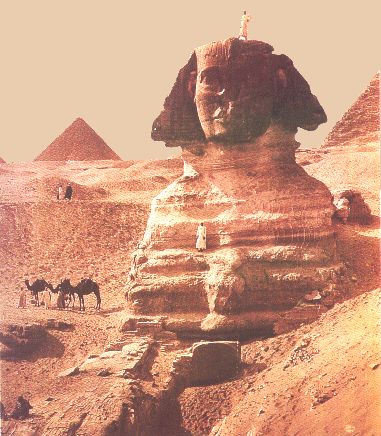 |
Phase I of the Sphinx's
Conservation:
Thutmosis IV and other New Kingdom (18th- 19th Dynasties)
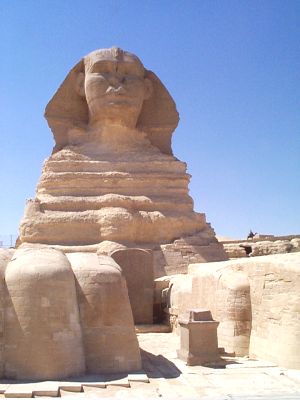 |
Evidence
for Thutmosis IV's campaign is preserved in the so-called dream Stele he erected between
the two paws of the Sphinx in ca. 1400 BC. According to the story he inscribed in the
Stella, prince Thutmosis went hunting in the Valley of Gazelles southeast of the Sphinx.
The Sphinx spoke to him in a dream and asked the prince to free him from the sand. The
Sphinx (Hor-em-Akht) offered in return the crown of Upper and Lower Egypt.
From this story we know that the Sphinx was buried up to its neck in sand by
1400 BC.
The implication of the Thutmosis stela is that he freed the monument from the
sand and thereby became pharaoh. Indeed, Thutmose IV's commitment to the Sphinx would
explain the revival of cultic practice focusing on the Sphinx during that king's reign.
As mentioned above, the Sphinx became an important focus for a popular and
royal cult under the name Hormakhet, "Horus in the Horizon," a combination of
the god of kingship, Horus, and the sun god Re.
|
The archaeological record confirms that Thutmosis did
indeed free the Sphinx of sand. Mudbrick walls, inscribed with the name of this king,
survive in remnants in the precinct. 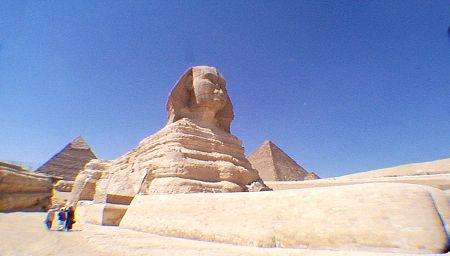 The very fact that Thutmosis built these walls suggests that
Thutmosis IV excavated the Sphinx and also cleared completely the sand as Baraize did
centuries later in 1926. The walls would have afforded a barrier against the elements and
halted reburial in the sand with regard to the matter of the dream Stela itself. There is
also a second element to Thutmosis IV's campaign of conservation. This concerns the course
of limestone blocks facing the core. It seems likely to me that the weaker part of the
mother rock was probably further damaged when the Sphinx was restored in the 18th-Dynasty
1200 years after its original carving. When the 18th- Dynasty excavators uncovered the
Sphinx, I believe they found a situation much like that found by Baraize in the course of
his excavations, when he cleared the statue completely for the first time for the Egyptian
Antiquities Service in 1926. In Baraize's case, the sand had buried the statue nearly to
the top of its back. As his men hauled away the sand and debris that had accumulated over
the ages, they found many large and small restoration blocks that had gradually fallen off
the curves of the lion's body, down to about one third the height of the north side of the
body, and to about two thirds the height of the body on the south side. Baraize simply
took many of these stones, including the large ones of the phase I restoration, and
cemented them back into place on the Sphinx's body. The very fact that Thutmosis built these walls suggests that
Thutmosis IV excavated the Sphinx and also cleared completely the sand as Baraize did
centuries later in 1926. The walls would have afforded a barrier against the elements and
halted reburial in the sand with regard to the matter of the dream Stela itself. There is
also a second element to Thutmosis IV's campaign of conservation. This concerns the course
of limestone blocks facing the core. It seems likely to me that the weaker part of the
mother rock was probably further damaged when the Sphinx was restored in the 18th-Dynasty
1200 years after its original carving. When the 18th- Dynasty excavators uncovered the
Sphinx, I believe they found a situation much like that found by Baraize in the course of
his excavations, when he cleared the statue completely for the first time for the Egyptian
Antiquities Service in 1926. In Baraize's case, the sand had buried the statue nearly to
the top of its back. As his men hauled away the sand and debris that had accumulated over
the ages, they found many large and small restoration blocks that had gradually fallen off
the curves of the lion's body, down to about one third the height of the north side of the
body, and to about two thirds the height of the body on the south side. Baraize simply
took many of these stones, including the large ones of the phase I restoration, and
cemented them back into place on the Sphinx's body. |
Thutmosis IV's workmen seem to have done something very similar. On the upper
part of the body we found old kingdom blocks, of the same quality used to face the
causeway of Khafre, reset against a badly weathered old kingdom core. As the dream Stela
of Thutmosis IV shows that this was the first time that the Sphinx ever spoken and hence
won its freedom from the sand, it is clear that there was plenty of time between Chaffer
and Thutmosis IV, i.e, 1119 years at least, for the old kingdom casing stones to have
fallen off, and for the weak stone of the Sphinx body to have weathered to the condition
that we see it under the phase I restorations of the upper Sphinx body. This weak stone
weathers very quickly even today in a process of flaking and powdering that leaves freshly
fallen stone flakes and dust at the base of these layers in the side of the Sphinx ditch.
Therefore, Thutmosis IV's
activities (phase 1 of conservation) consisted of the following:
1) After clearing away the sand in the precinct, he built the protective mud
brick walls around the Sphinx to protect it from wind and sand.
2) He discovered that the Sphinx was damaged and that the old kingdom
stones were falling down. He put them back in their original places, and may have
commissioned more.
3) He brought a granite stela from Aswan and inscribed the story known as
the dream story.
To Ramesses II may be attributed the two stelae between the two front paws of
the Sphinx and the other artifacts inscribed with his name that were found there. The
existence of these objects suggests that he may also have engaged in restoration
activities at the Sphinx, such as replacing some of the fallen stones that had been
restored by Thutmosis IV. Ramses's son, Kha-em-wase, known as the first Egyptologist and
restorer, may also have restored the sphinx in the same manner as his father. The Turin
papyrus mentions that workmen in the time of Ramesses lI took stone for Hor-m-mn-nfr. Some
scholars have recognized in this name the Sphinx's name Horoun, one of the names used in
the New kingdom to refer to the Sphinx. Artifacts attributed to other kings, e.g., Ay,
Horemheb, Seti I, and Merenptah, have also been discovered in the area of the Sphinx, but
there is no evidence to suggest these kings sponsored any restorations of that great
monument.
Phase II of the Sphinx
conservation:
Saite period (500 BC)
In 1853 A. Mariette found
the so-called Inventory Stela, or, the so-called Stela of the daughter of Cheops (Khufu).
It was found on the east side of the pyramid of GIC, located on the east side of the great
pyramid and dated to the 26th Dynasty. The stela indicates that the Sphinx was repaired in
this period. To this period may be attributed the major layer of restoration masonry on
the upper part of the Sphinx's body on the south side. This layer, composed of smaller
slabs than those of the Old Kingdom, was laid over the earlier (phase I) layer of
Thutmosis, the surface of which was cut away in phase II, however, for fitting the new
stones. It is important to note here that the restorers did not remove the Old Kingdom
stones from the Sphinx. The Saite restoration also focused on the Sphinx's tail and on the
(nemes) headdress. The Egyptians of this period may also have painted the Sphinx. There is
no evidence, however, of any excavations around the base of the Sphinx in this period.
Even Herodotus is silent on the Sphinx, suggesting that it was at least partially obscured
with sand.
Phase III of the Sphinx
Conservation:
Roman period (30 BC-end 2nd century
AD)
The ancient sources
attest that the Sphinx was in the Roman period again freed from the sand. For example, the
people of Busiris, a village located at the foot of the Khufu pyramid, left a stela in
honor of Nero and the Governor, Claudius Babillus. We know also that the Sphinx in the
Roman period was a popular gathering place. The Egyptians apparently came to sit by the
Sphinx and the place was highly romanticized.
The Sphinx even served as
the backdrop for the performance of plays. These literary references, plus the nature of
the Roman restorations, indicate that the monument was in full view.
The Roman restorations
consisted of a layer of protective stones applied to the paws and two sides of the Sphinx.
These stones were recorded and planned by Mark Lehner (from the Oriental Institute) in the
photogrammetric map that was made in 1979.
These stones were applied
directly over the old kingdom courses; smaller stones were used as necessary to retain the
modeling and proportions of the Sphinx. In addition.
the floor of the Sphinx
sanctuary was paved during the Roman period. This phase of work can be considered as the
largest restoration effort in history.
Our studies of the Sphinx
indicate that old kingdom stones placed on the Sphinx were respected by subsequent
generations of restorers. They may have been considered sacred. As in the case of their
Saite predecessors mentioned above, the Roman restorers did not remove the old kingdom
stones from the Sphinx. The layers of the Roman period are composed of small brick-sized
stones that were placed on the top of, not in the place of, the old kingdom stones and
later casing. The fact that the Roman restorers did not violate the original stones
suggests they considered these venerable, older stones sacred.
Phase IV of the Sphinx
conservation:
Baraize (1925-1936)
Many centuries ensued
before the next phase of conservation was undertaken, this time by Emile Baraize. For
almost eleven years Baraize cleared the area around the Sphinx to free it from sand. The
dimensions of these undertakings had their only precedents in the reign of Thutmosis IV in
1400 BC and in the Roman period. This is made particularly clear by Baraize's records,
which are comprised of notes and 226 photographs.
Baraize's restoration
program (phase IV) and its consequences are summarized as follows:
1) Baraize's clearing
operations revealed that the old kingdom stones returned to their original positions by
Thutmosis were again falling down. The records show that a crack located at top center
divided the Sphinx into two parts. The head was in bad condition. A large passage, the
size of which is indicated by the workmen standing in it, was open on the north ridge.
Baraize restored the head with cement, for at the time it was deemed necessary for the
protection of the head. But since we now know from the UNESCO investigations that the
upper part of the Sphinx is relatively strong, it is now desirable to reverse this work.
The cement restoration of the head is not good and obscures the impressiveness of the
Sphinx. Therefore, one suggests that Baraize's restoration of the head be reversed.
2) Baraize closed the
northern passage with masonry. It would be of advantage to open it in order to view the
interior of the lion's body and take samples. The northern side of the Sphinx is a big
problem, as the deterioration of the casing stones here is in a more advanced state.
3) Baraize restored the
crack on the top of the Sphinx with cement and replaced the old kingdom stones.
4) He also restored many
other parts on the Sphinx, which were recorded by Lehner in 1979. Baraize's work can be
seen now on the left and right shoulder of the Sphinx and on the southern shoulder where
he restored a fallen chunk from the mother rock.
Also parts on the
southern, northern, and the back of the lion body were restored.
However, most of
Baraize's restorations have been taken out and restored with the new method currently in
use on the south side (see phase VI of the Sphinx conservation).
Phase V of the Sphinx
conservation:
Egyptian Antiquities Organization (1955-1987)
Phase V as described here
consists of a series of sporadic restorations carried out by the Egyptian Antiquities
Organization's restoration department in 1955, 1977,1979, and 1982-1987. There was no
over-arching plan of work, nor was the conservation work that was completed recorded or
photographed. The workmen were mainly doing work without any supervision by an architect
or conservator. As a result, this work did not help for preservation the Sphinx.
In 1955 a temporary
restoration work was done on the Sphinx, primarily in the areas that very thin layers of
limestone in the area of the chest had started to flake off.
Restorers began to inject
the chest with a chemical substance. The injection was done only in the surface layer of
the chest. Two months later, this layer began to fall down and we still have this problem.
In September 1979, the
architecture department of the Egyptian Antiquities organization (EAO) began restoration
on the northern side of the Great Sphinx. This work was carried out by workmen working
with only monthly supervision by the architect. The workmen started to add new stones to
the north side while simultaneously taking the earlier stones out. Some of the stones
taken out were ancient, and others belonged to Baraize's restoration. Unfortunately, the
workmen used mortar which consisted of cement and gypsum, a formula well-known even at the
time to be harmful to the monuments. When it was discovered that this was the case, the
work was suspended.
In October 1981 veneer
stones began falling off the north hind paw of the Sphinx.
This alarming event did
not go unnoticed by the press. The newspapers called attention to the increasingly
dilapidated condition of the Sphinx and demanded a change in the EAO. Hence, many experts
from the Faculty of Archaeology and other institutions initiated studies on the Sphinx.
Research on the water table and pollution, and analyses of mortar and stone were conducted
. However, none of the findings and recommendations forthcoming from these studies were
ever applied in practice to the Sphinx.
In 1981-1982, the newly
formulated Sphinx committee met to discuss the conservation needs of the Sphinx. These
discussions led to their unfortunate decision to remove the Roman stones and apply large
stones on the Sphinx. These stones, which remain today, are similar neither to the
pharaonic nor the Roman stones. The reasoning underlying the use of such visually
incongruent stones was that little mortar was required in this procedure.
The architect of the
Egyptian Antiquities Organization directed the restoration program from 1982-1987. The
biggest problems in this phase of the work are the following:
1) They did not use the
mortar recommended in the scientific report but instead used a very large amount of cement
and gypsum. Furthermore, they put the mortar directly on the mother rock.
2) Again, the workmen had
no supervision from any member of the Sphinx committee. The architect in charge came
personally only rarely to the site.
3)The large stones used
in the restoration completely obscured the modeling and the proportions of the Sphinx.
This casing was applied on the south paw, north paw, the northern side, the back, the
tail, the masonry boxes, the Roman stairs, the Sphinx sanctuary, and the back paw of the
northern side. All these places look completely new and strange.
4) Rather than given
priority to the weak areas, such as the shoulders and the top of the haunches, this effort
focused attention on cosmetic renovations. These latter were in fact done badly. The
"restoration" consisted merely of removing stones and mortar and replacement
works. They also added buttresses of stone and mortar (again, cement and gypsum) over the
mother rock of the Sphinx on the rump, north, and part of the south side.
5) They removed all the
ancient stones that were added to the Sphinx in the phase III restoration. These stones
were never recorded or saved in storage.
6) The Giza branch of
EAO, whose personnel were at the time best equipped to supervise the work, was not
permitted to have a role in over-seeing the work.
7) A wall was built on
the north side which, among other things, completely obscured the modeling of the Sphinx's
shoulder. This was wholly unwarranted archaeologically; it is based purely on imagination
rather than evidence.
The results of this type
of work on the Sphinx were: 1) The Sphinx body could not tolerate such a huge amount of
mortar (cement and gypsum). The mother rock of the Sphinx could not "breathe"
and began to push the newly applied stones out. This was especially the case on the back
of the northern paw and the area of the tail.
2)
Deterioration and salt started to appear on the new stone. The salt problem appeared even
during the work on the back northern paw. To counteract this deterioration they covered
this area with mud.
3) The workmen cut the
claws that had been carved in the stone by the ancient Egyptians.
All these reasons led to
the suspension of work in November 1987.
In February 1988, a chunk
of limestone on the southern shoulder of the Sphinx fell off. The weakness of this part
had long been known. Indeed it was restored initially by Baraize and it is obvious in all
the Sphinx photographs that this area needed attention. yet, no reparations had been
carried out in this area during the 1982-1987 activities. The media made a case of it and
the Sphinx became a political issue as also had happened in the reign of Thutmosis IV in
1400 BC and in 1981 when veneer stones fell off the north hind paw of the Sphinx.
Phase VI of the Sphinx
conservation
(1989-present)
Since it was uncovered by Baraize in 1926 the Sphinx has been under siege from many
elements. These are:
1) The rising water
table.
2) Vibrations emanating
from aircraft and vehicular traffic, especially buses, in the immediate vicinity of the
area.
3) People living around
the Sphinx, in particular the villagers of Nazlet-el-Samman and Kafr-el-Gebel. The
population of the former has now reached 200,000.
4) The leaking of waste
water from nearby villages which lack sewage containment systems.
5) The modern
construction of the Sound and Light show installation and the cutting of the tunnels for
cables.
6) Climatic factors, such
as rain and fluctuations in humidity and temperature.
7) Modern technology,
such as factories near the monument and the resulting pollution.
8) The practice of
utilizing stop-gap and harmful methods of conservation, restoration, particularly those
using cement and gypsum on the mother rock of the Sphinx's lion body.
9) The limestone quarry
near the Giza plateau, which uses dynamite to pulverize lime for use in sugar factories.
Since 1988 many foreign
experts have come to the Sphinx to investigate and offer solutions to these problems. All
have agreed that the new casing stones and the cement should be taken off immediately.
In 1989 a Sphinx
committee, consisting of appointees from different divisions of the EAO and from Egyptian
universities, was established. Under the late DR. Sayed Tawilk, the chairman of the E.A.O.
To whom we Owe a great deal of thanks, the support and the efforts of Mr. Farouk Hosni,
the Minister of Culture was very important for the success of the project. In addition,
the late Sayed Tawilk and the author, among others, appointed a group of specialists who
were to work on the site.
The team used the
elevations and plans that had been produced in 1979 by the American Research Center in
Egypt. Sphinx project and that of the German Institute as guides to begin restoring the
contours of the Sphinx as they existed prior to 1982-88 interventions.
The project was divided
into three phases. The first, which is currently drawing to a close, has consisted of
carrying out many scientific studies as well as doing restorations work in select areas.
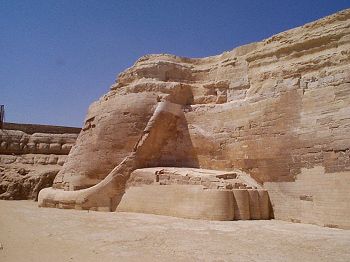
The areas include the
southern paw, the southern side of the Sphinx, and the tail. In this work both the
photogrammetric map of the Sphinx project and the old Baraize photographs have been used
as a basis directing reconstruction. The old large stones and cement were all removed and
the mother rock was treated. New stones were chosen from a quarry at Helena after analysis
had shown it was consistent with the limestone of the mother rock. Rather than use thin
facing slabs that would require lots of mortar, we elected to use whole blocks of stones,
placed end first against the mother rock and laid in overlapping courses; this system, the
norm in brick laying, interlocks the stones and permits ease of replacement. The mortar
was made of lime and sand mixed in proportions of 1:3. The mixture was allowed to stand in
plastic bags for 10-15 days to allow for maximum congealment. In this first phase also the
chest was given a protective course of limestone on the sides matching the construction
techniques of the original.
The scientific studies
associated with the first phase of our current campaign have yielded many important
insights toward the future conservation needs of the Sphinx. The outcome of studies on the
level of the water table carried out by the National Research Institute of Astronomy and
Geophysics is of particular interest: the studies show the water level is now seven meters
below the base of the Sphinx. This is down five meters from the situation that prevailed
for at least 50 years. The drop in the water table may be a consequence of the new sewage
system that the Egyptian government constructed in the last two years in the village of
Nazlet el-Samman.
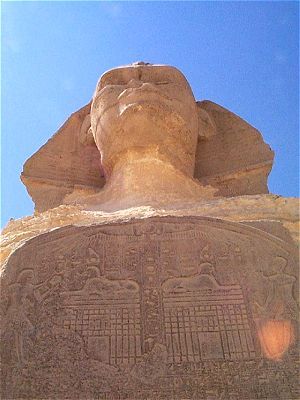 A
major concern about the strength of the head and neck was also alleviated through a
diagnostic examination of the Sphinx by a team from UNESCO. This work was done under B.
Changneaud and A. Bouineau. One of the results that the head of the Sphinx, is the
strongest part.
A
major concern about the strength of the head and neck was also alleviated through a
diagnostic examination of the Sphinx by a team from UNESCO. This work was done under B.
Changneaud and A. Bouineau. One of the results that the head of the Sphinx, is the
strongest part.
This phase of
conservation has secured an improvement in the Sphinx's environment as a result of another
study by the National Research Institute of Astronomy and Geophysics, this one of the
seismic waves emanating from blasting activities at quarries in the vicinity. These waves
were determined to be of potential hazard to the Sphinx. Therefore, based on
recommendations from this study, limits were placed on the size of the blasts, and
schedules were established to space out the detonations so as to prevent overlapping.
Recording stations were set up in the Sphinx complex to monitor compliance with these
restrictions.
In May 1990 the Getty
Conservation Institute of the United States installed a solar- powered monitoring station
on the back of the Great Sphinx designed to measure such potentially destructive
environmental factors as wind, precipitation, relative humidity, and condensation. Data
collected thus far indicate the strong, sand-bearing northwest wind as the principle
source of wind erosion. They also indicate that moisture in the atmosphere, reacting on a
daily basis with salts contained in the limestone, contributes at least in part to the
surface flaking of the Sphinx.
Samples of rock taken
from the Sphinx and surrounding outcrops were analyzed by the Petroleum Research Institute
in Cairo, permitting composition analyses.
Petrographic and x-ray
diffraction analyses indicate, among other things, that the uppermost layers of the Sphinx
are composed of marly limestone, the heterogeneous nature of which contributes to
decomposition. The lower parts, on the other hand, are composed of fossiliferous limestone
which, while harder and more compact, raise other conservation concerns. Analysis of the
data is on-going and one looks forward to the full publication of the results in the near
future.
The center of
Archaeological Engineering has submitted to EAO a plan for the next two phases of
conservation. These will include recording, sampling, and protecting the Sphinx from the
environment. The second phase is scheduled to start September 1, 1992. Areas selected for
attention are the chest and northern side of the Sphinx.
Issues include the
question of whether to inject the chest with a chemical substance to stabilize it or to
cover it with stone to protect it from wind erosion. Both these alternatives must be
carefully considered.
DIRECTION FOR FUTURE
CONSERVATION
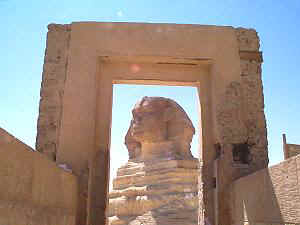 The
four-day multidisciplinary symposium held in Cairo, February 29-March 3, 1992, under Dr.
Farouk E1 Baz as president of the conference and Dr. Gaballah Aly Gaballah as
Egyptological advisor, brought together ninety scholars and specialists to review and
discuss the results of recent scientific applications in the assessment of conservation
needs of the Great Sphinx. Scientists, historians, geologists, chemists, artists, and
environmentalists addressed many of the issues involved in developing a global plan for
conserving the Sphinx. There were also useful discussions of the progress in the most
recent phase (1989-present) in the long history of conservation of the Sphinx and its
future directions. More importantly, however, was the demonstrated willingness of Egyptian
scholars to openly discuss the Sphinx issue, which has long been a source of heated
political and scholarly debate in their own country. collaborative receptiveness to
criticism and their frank invitation to Collaborative research is perhaps the single most
important step towards saving this precious monument. It is a clear admission that the
Great Sphinx is a world heritage and not that of Egypt alone. Indeed, a worldwide response
is now needed to face the enormous challenge that lays ahead.
The
four-day multidisciplinary symposium held in Cairo, February 29-March 3, 1992, under Dr.
Farouk E1 Baz as president of the conference and Dr. Gaballah Aly Gaballah as
Egyptological advisor, brought together ninety scholars and specialists to review and
discuss the results of recent scientific applications in the assessment of conservation
needs of the Great Sphinx. Scientists, historians, geologists, chemists, artists, and
environmentalists addressed many of the issues involved in developing a global plan for
conserving the Sphinx. There were also useful discussions of the progress in the most
recent phase (1989-present) in the long history of conservation of the Sphinx and its
future directions. More importantly, however, was the demonstrated willingness of Egyptian
scholars to openly discuss the Sphinx issue, which has long been a source of heated
political and scholarly debate in their own country. collaborative receptiveness to
criticism and their frank invitation to Collaborative research is perhaps the single most
important step towards saving this precious monument. It is a clear admission that the
Great Sphinx is a world heritage and not that of Egypt alone. Indeed, a worldwide response
is now needed to face the enormous challenge that lays ahead.
Phase II of the Modern
Sphinx Restoration.
This phase was very
important because the Sphinx's north side had the following:
1- Large stones had been
placed that do not match those of the Old Kingdom or Roman period.
2- Three meters of cement
were put on this side.
3- Salt began to appear
on the left paw.
4- Stones started to move
from north side because of pressures caused by the fact that the cement prevented the
limestone from breathing.
5- The proportions of
that side were completely lost because of faulty restoration.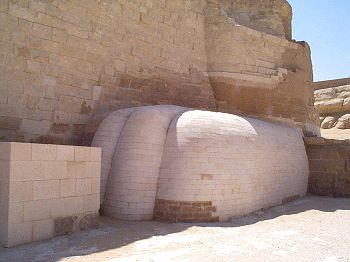
We started to
mechanically remove the new stones and cement.
Then Mahmoud Mabrouk the
sculptor began to do the modeling with large stones similar to the pharaonic period (New
Kingdom).
Meanwhile the
conservation of the upper part of the body was continued by our restoration.
Documentation of all the
work was done by the architects and the archaeologists.
Phase III of the Sphinx
Restoration:
This phase is connected with the chest of the Sphinx. Discussion
during the conference led to following solution:
1- To restore the chest with chemicals that could stop the flaking of the
Sphinx chest.
2- To reconstruct the chest with masonry The second solution discussed above
can not apply to the Sphinx because we do not know what the chest of the Sphinx looked
like. In ancient times, we can not add stones because we should not reconstruct. The
Sphinx is a ruin and we should keep it as a ruin.
The other solution also can not be applied to the Sphinx because chemicals
would not work well with the natural limestone. We found out that the best solution for
the Sphinx's chest was the following: 1- The lower part of the Sphinx was restored with
stones.
2- All the middle, upper part and the neck were restored with mortar consist of
lime and sand. On December 25, 1997, we took away the scuffling out and announced the
final phase of the Sphinx restoration. But it is very important to note that the Sphinx is
the oldest patient and we should stay near him all the time.
The Restoration team:
The Sphinx
Restoration project under the supervision of H.E. Farouk Hosni, Minister of Culture.
| Dr.
Gaballa Ali Gaballa |
General
Secretary of the Supreme Council of Antiquities & other General Secretaries. |
| Dr. Zahi Hawass |
Director |
| Adam Henein |
Sculptor (from
1992 1995) |
| Dr. Mahmoud
Mabrouk |
Sculpture
Supervisor and Artist (1989 - 1998) |
| Dr. Shawki
Nakhla |
Scientific
Director |
Special thanks
to the late Dr. Sayed Tawfik who initiated the project.
| Architectual
Engineers: |
- Abdel Hamid Kotb
- Adel Amin Zaki
|
| Archaeologists: |
- Nassau Mohamed Ramadan.
- Emad Fahmy Mohamed.
|
| Conservation: |
- Moustafa
Abdel Kader, head of conservation.
- Mohamed Sayed Mabrouk. Assistant
|
| * Technical Supervision: |
- Said
Hassan Mohamed. Overseer of Sculpture.
- Yassien Mohamed Ahmed. Assistant. |
Cost:
80 Thousand Egyptian Pounds (per month)
* Project started in January 1989.
December 25,
1998.
the final stage of the restoration.
* The Sphinx Book:
"The Secrets of the Sphinx Restoration, past and present".
Published by Samir Gharieb Director of the Development Fund of the Ministry of Culture in
Collaboration with Mr. Mark Linz, Director of the American University in Cairo press.
Report -
Copyright (c) 1998 - Dr. Zahi Hawass
All Rights Reserved
Photos - Copyright (c) 1997-98 - Andrew Bayuk
All Rights Reserved
BACK TO The World Celebration of the Sphinx
Visit Guardian's
Sphinx
VISIT Guardian's Egypt
BACK to The Plateau Homepage



 The very fact that Thutmosis built these walls suggests that
Thutmosis IV excavated the Sphinx and also cleared completely the sand as Baraize did
centuries later in 1926. The walls would have afforded a barrier against the elements and
halted reburial in the sand with regard to the matter of the dream Stela itself. There is
also a second element to Thutmosis IV's campaign of conservation. This concerns the course
of limestone blocks facing the core. It seems likely to me that the weaker part of the
mother rock was probably further damaged when the Sphinx was restored in the 18th-Dynasty
1200 years after its original carving. When the 18th- Dynasty excavators uncovered the
Sphinx, I believe they found a situation much like that found by Baraize in the course of
his excavations, when he cleared the statue completely for the first time for the Egyptian
Antiquities Service in 1926. In Baraize's case, the sand had buried the statue nearly to
the top of its back. As his men hauled away the sand and debris that had accumulated over
the ages, they found many large and small restoration blocks that had gradually fallen off
the curves of the lion's body, down to about one third the height of the north side of the
body, and to about two thirds the height of the body on the south side. Baraize simply
took many of these stones, including the large ones of the phase I restoration, and
cemented them back into place on the Sphinx's body.
The very fact that Thutmosis built these walls suggests that
Thutmosis IV excavated the Sphinx and also cleared completely the sand as Baraize did
centuries later in 1926. The walls would have afforded a barrier against the elements and
halted reburial in the sand with regard to the matter of the dream Stela itself. There is
also a second element to Thutmosis IV's campaign of conservation. This concerns the course
of limestone blocks facing the core. It seems likely to me that the weaker part of the
mother rock was probably further damaged when the Sphinx was restored in the 18th-Dynasty
1200 years after its original carving. When the 18th- Dynasty excavators uncovered the
Sphinx, I believe they found a situation much like that found by Baraize in the course of
his excavations, when he cleared the statue completely for the first time for the Egyptian
Antiquities Service in 1926. In Baraize's case, the sand had buried the statue nearly to
the top of its back. As his men hauled away the sand and debris that had accumulated over
the ages, they found many large and small restoration blocks that had gradually fallen off
the curves of the lion's body, down to about one third the height of the north side of the
body, and to about two thirds the height of the body on the south side. Baraize simply
took many of these stones, including the large ones of the phase I restoration, and
cemented them back into place on the Sphinx's body. 
 A
major concern about the strength of the head and neck was also alleviated through a
diagnostic examination of the Sphinx by a team from UNESCO. This work was done under B.
Changneaud and A. Bouineau. One of the results that the head of the Sphinx, is the
strongest part.
A
major concern about the strength of the head and neck was also alleviated through a
diagnostic examination of the Sphinx by a team from UNESCO. This work was done under B.
Changneaud and A. Bouineau. One of the results that the head of the Sphinx, is the
strongest part.  The
four-day multidisciplinary symposium held in Cairo, February 29-March 3, 1992, under Dr.
Farouk E1 Baz as president of the conference and Dr. Gaballah Aly Gaballah as
Egyptological advisor, brought together ninety scholars and specialists to review and
discuss the results of recent scientific applications in the assessment of conservation
needs of the Great Sphinx. Scientists, historians, geologists, chemists, artists, and
environmentalists addressed many of the issues involved in developing a global plan for
conserving the Sphinx. There were also useful discussions of the progress in the most
recent phase (1989-present) in the long history of conservation of the Sphinx and its
future directions. More importantly, however, was the demonstrated willingness of Egyptian
scholars to openly discuss the Sphinx issue, which has long been a source of heated
political and scholarly debate in their own country. collaborative receptiveness to
criticism and their frank invitation to Collaborative research is perhaps the single most
important step towards saving this precious monument. It is a clear admission that the
Great Sphinx is a world heritage and not that of Egypt alone. Indeed, a worldwide response
is now needed to face the enormous challenge that lays ahead.
The
four-day multidisciplinary symposium held in Cairo, February 29-March 3, 1992, under Dr.
Farouk E1 Baz as president of the conference and Dr. Gaballah Aly Gaballah as
Egyptological advisor, brought together ninety scholars and specialists to review and
discuss the results of recent scientific applications in the assessment of conservation
needs of the Great Sphinx. Scientists, historians, geologists, chemists, artists, and
environmentalists addressed many of the issues involved in developing a global plan for
conserving the Sphinx. There were also useful discussions of the progress in the most
recent phase (1989-present) in the long history of conservation of the Sphinx and its
future directions. More importantly, however, was the demonstrated willingness of Egyptian
scholars to openly discuss the Sphinx issue, which has long been a source of heated
political and scholarly debate in their own country. collaborative receptiveness to
criticism and their frank invitation to Collaborative research is perhaps the single most
important step towards saving this precious monument. It is a clear admission that the
Great Sphinx is a world heritage and not that of Egypt alone. Indeed, a worldwide response
is now needed to face the enormous challenge that lays ahead. 